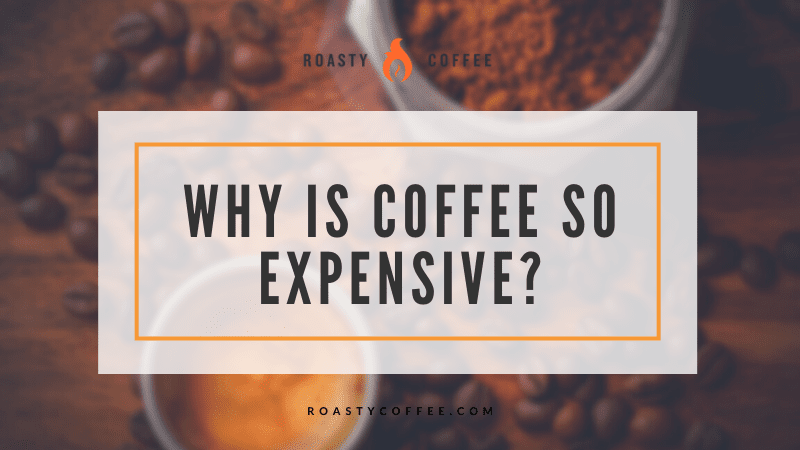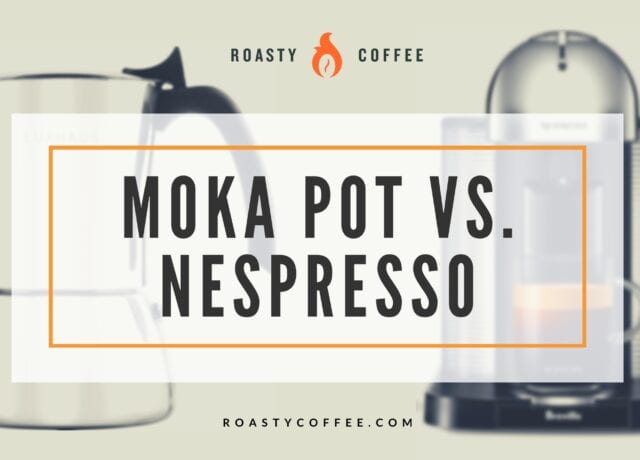Coffee is one of the most popular beverages in the world. The exact origins of coffee are unknown, but it has been around for hundreds of years, with many legends about its discovery. The most famous is an Ethiopian legend about a goat herder.
Coffee now has a whole culture around it and is enjoyed on a daily basis by people of all ages worldwide.
It has become an essential part of Western culture, with coffee breaks becoming a vital part of the workday and coffee shops becoming an excellent spot for a friend meetup or a first date.
Unfortunately, despite its popularity and easy access, coffee can be a costly luxury item, especially the good stuff. Let’s take a look at coffee and figure out why it can be so pricey.

Recommended: How to Buy The Best Coffee Beans
Growing Pains
One reason coffee is so expensive is the coffee farming and harvesting process. A coffee plant can take three to five years to mature and start bearing fruit containing the seeds we know as coffee beans.
Farmers have to be vigilant against all manner of plant diseases and pests.
Once the plants consistently bear multiple usable fruits, they are ready for harvesting. This harvesting process takes several steps, and the exact method used often impacts the price of the final product in grocery stores.
In addition, most coffee plants can only be harvested once a year. Some climates permit harvesting twice a year. This harvesting availability also has an impact on price.
There are three different ways of harvesting coffee: selective picking, strip harvesting, and mechanical harvesting.
Selective Picking
Some coffee producers harvest their crops by hand. This selective picking allows them to make sure they pick only the best mature fruit.
The coffee cherry pit is what will ultimately become a delicious coffee bean. However, this coffee production process is incredibly time-consuming and, thus, more expensive.
Strip Harvesting
Other coffee producers harvest through a process called strip harvesting. This process is very cost-effective as all fruit is taken from the trees, no matter the maturity of the individual fruit. However, it also produces a lower quality coffee.
Mechanical Harvesting
Stripping machines are for flatland use only. On coffee farms with various types of topography, mechanical harvesting may be used. Mechanized picking also allows producers to harvest only the ripe coffee fruit by using machines instead of by hand.
Once the farmers harvest the coffee, it can be processed.
It’s Getting Hot in Here: Processing and Roasting
Once the harvest is complete, it needs to be processed and roasted. There are two main processing methods for coffee: dry and wet. Both ways influence the final taste of the coffee.
The processing method also influences the price of the coffee, as wet processing is more expensive. It requires more steps and machines than dry processing, thus raising the price.
Once the coffee fruit is processed, it can begin the roasting process. However, this process is tricky and requires knowledge and expertise. Knowing when to start, stop, and how long to cool the roasted coffee beans all impact the final taste.
Many factors impact the taste of coffee, and these combinations are incredibly complex.
The technical expertise and knowledge around coffee processing and roasting can increase costs for coffee companies.
This knowledge is crucial for coffee producers, as the demand for a high-quality cup of coffee has increased significantly over the years.
The sludge from the past is gone, and high-quality, great-tasting cups of coffee are in.
Location is Everything
Brazil produces the most coffee globally, with other notable hotspots including Vietnam, Indonesia, and multiple countries in South America, Central America, and Africa.
Very little coffee is grown in the United States, although there are many local coffee roasters.
Hawaii is the exception, as it is the only US state where coffee is grown. In fact, coffee is one of Hawaii’s top products.
Because most coffee is grown elsewhere and has to be shipped to the US, these shipping and transportation costs, along with various regulations and customs procedures, only increase the end prices for coffee.
What About Cafes?
As mentioned above, many factors influence the cost of coffee beans. However, rising business costs mean grabbing a cold-brewed coffee at your local spot is also more expensive.
Equipment and Business Expenses
Starting a coffee shop and maintaining it is not cheap.
Not only are startup costs high in the coffee industry, with the cost of various coffee machines, but the costs of maintaining a shop, such as fixing or replacing machines as they break, and paying for utilities and workers, can get expensive fast.
Labor
Since the COVID-19 pandemic started, not only is there a labor shortage, but the cost of labor has been increasing in the US for the last couple of years.
Coffee shops require many workers, from those making the pumpkin spice lattes to managers and buyers. Those people all need to be paid, and this market demands a higher price for them to stay.
Marketing and Packaging
Marketing for businesses, in addition to logos, labels, packaging designs, and packing materials are expensive.
These costs add up but are needed for a commercial coffee shop to do well, especially one that roasts its own coffee and sells bags of coffee beans in addition to ready-to-order drinks.
Drink Offerings
Most coffee shops don’t just offer lattes or drip coffee anymore. Baristas need to be skilled at making a variety of expensive coffee drinks. It is labor-intensive work, and training workers in this skill can add up.
In addition, having the equipment for different types of drinks, ice for iced beverages, and the various syrups and milk alternatives on hand can mean quite an inventory for the shop. All of this has a price.
Everything Mentioned Above
On top of all of these business expenses, the base price of coffee beans can be high, especially for those higher-quality beans. Once you factor in the costs of owning and running a business like a coffee shop, it makes sense why each latte is so pricey.
Other Factors Affecting Coffee Price
In addition to the work and labor it takes actually to grow and produce the best-tasting coffee, there are other factors at play that can also make your favorite cup of joe more expensive.
Supply and Demand
Like any other commodity, supply and demand can impact price. Higher quality coffee is in demand, and consumers will pay a pretty penny for the best.
As consumers learn more about coffee and where it comes from, fair wages and fair trade for those who pick the coffee is becoming an important social issue. Fairtrade and ethically sourced coffee is becoming popular among consumers but is more expensive.
The Fairtrade certification means that coffee beans are grown in a way that supports the producers and laborers who farm the beans, as well as protecting and preserving the environment.
In addition, as mentioned before, higher quality and specialty coffee have become increasingly popular. It’s not just decaf, regular, and dark-roast anymore.
Now coffee includes many different roasts, varieties, and flavors. On top of that are all the types of coffee drinks available in coffee shops, like lattes, cappuccinos, americanos, flat whites, etc.
In terms of the supply chain, COVID-19 has had enormous impacts on multiple commodities.
Shipping containers are in short supply, and since many coffee consumers are in the West, where coffee is not grown, getting significant amounts of coffee to them is proving to be a challenge.
Environmental Impacts
Coffee plants are delicate creatures. Environmental impacts such as drought, excessive rain, or storms can have devastating effects on coffee yield and wholesale prices.
Disease and pests are also something to consider as well. The coffee berry borer, the most economically devastating coffee pest globally, wreaks havoc on coffee plants, causing millions of dollars in damages each year.
Unfortunately, this pest is also spreading through climate change. As the world warms up, the coffee berry borer can survive in locations it couldn’t before.
Climate Change
Besides increasing the range of the coffee berry borer, climate change is also causing other negative impacts on coffee bean production and is making it difficult to grow.
Coffee rust, or coffee leaf rust, is a fungus that is spreading thanks to climate change. It is the most economically impactful coffee disease in the world.
Even though it has been around for a few hundred years, climate change can cause coffee rust to spread more quickly and make coffee plants more vulnerable to the disease.
The coffee berry borer and coffee rust aren’t all that coffee farmers need to worry about. The warming climate is causing extreme weather events, making drought, storms, and excessive rainfall even more common.
Increasing temperatures are also making some places too warm to grow coffee.
Wrapping Up
There are many reasons why coffee is so expensive. It starts with growing and harvesting the coffee and only increases from there.
Each coffee bean goes on quite a journey to get to your cup, and when you think about all the hard work that goes into it, it makes sense why coffee can be so expensive.
Happy Caffeinating!







